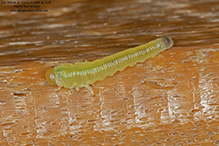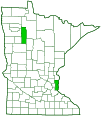Roseslug
(Endelomyia aethiops)
Conservation • Description • Habitat • Ecology • Distribution • Taxonomy
Conservation Status |
|||
| IUCN Red List | not listed |
||
| NatureServe | not listed |
||
| Minnesota | not listed |
||
Description |
Roseslug is a very small common sawfly. It is native to northern Europe. It was introduced into North America, and now occurs from coast to coast in northern United States and southern Canada. It is uncommon in Minnesota. Adults are wasp-like and ⅛″ to 3 ⁄16″ (4 to 5 mm) long. The head, thorax, and abdomen are black. The abdomen is broadly joined to the thorax. The antennae are black, thread-like, and have nine segments. The wings are uniformly tinged dark smoky brown. The forewing does not have a vein crossing the cell on the leading margin (intercostal vein). The hindwing has three basal cells. The legs are mostly black. The second leg part (trochanter) has two segments. On the front and middle legs, the tip of the third leg segment (femur) and all of the fourth segment (tibia) are yellowish-white. The larvae is looks like a caterpillar but is not. The term “caterpillar” refers only to larvae of moths and butterflies. The roseslug larva is up to ⅝″ (15 mm) long. The head is yellowish-brown. The body is translucent yellow. It often appears tinged green in the middle due to the contents of its gut. There are three pairs of true legs on the thorax and six pairs of fleshy, unsegmented, leg-like structures (prolegs) on the abdomen. |
Size |
Total length: ⅛″ to 3 ⁄16″ (4 to 5 mm) |
Similar Species |
Habitat |
|
Ecology |
Season |
One generation per year: May through late June |
Behavior |
Larvae feed on leaves of rose plants. They eat only the epidermis and spongy layers of tissue on the underside of the leaf between the veins. The tissue that remains turns brown. The resulting damage is called windowpane skeletonization. |
Life Cycle |
Adults emerge in May. The female cuts into a leaf edge with her saw-like ovipositor and deposits her eggs. The eggs develop into embryos without first being fertilized by sperm (parthenogenesis). In late June the larvae drop to the ground and pupate. Pupa overwinter. |
Larva Food |
Leaves of rose (Rosa spp.) |
Adult Food |
|
Distribution |
||
|
Sources |
|
| 8/31/2025 | ||
Occurrence |
||
Widespread but not common |
||
Taxonomy |
|
Order |
Hymenoptera (Ants, Bees, Wasps, and Sawflies) |
Suborder |
Symphyta (Sawflies, Horntails, and Wood Wasps) |
Superfamily |
Tenthredinoidea (Typical Sawflies) |
Family |
|
Subfamily |
Blennocampinae |
Tribe |
Caliroini |
Genus |
Endelomyia |
Subordinate Taxa |
|
|
|
Synonyms |
|
Eriocampa caninae Eriocampa testaceipes Poecilosoma nigricolle Selandria soror Tenthredo aethiops |
|
Common Names |
|
rose slug sawfly roseslug roseslug sawfly |
|
Glossary
Femur
On insects and arachnids, the third, largest, most robust segment of the leg, coming immediately before the tibia. On humans, the thigh bone.
Proleg
A fleshy structure on the abdomen of some insect larvae that functions as a leg, but lacks the five segments of a true insect leg.
Tibia
The fourth segment of an insect leg, after the femur and before the tarsus (foot). The fifth segment of a spider leg or palp. Plural: tibiae.
Visitor Photos |
Share your photo of this insect. |
||
This button not working for you? |
||
Alfredo Colon |
 |
MinnesotaSeasons.com Photos |
|

Slideshows |
|

Visitor Videos |
Share your video of this insect. |
||
This button not working for you? |
||
|
Other Videos |
Common Roseslug Sawfly Larvae - Endelomyia aethiops - Macro HD |
About
Sep 9, 2018 Second instar common roseslug sawfly larvae (Endelomyia aethiops) being cute as heck! They’re also referred to as “rose skeletonizers”. Many people confuse sawfly larvae for caterpillars, but they are very different in many ways! For more videos like this, follow me on IG at @garbage.nobility and/or check my personal arthropod related tag #garbagearthropodsetc to see all of my arthropod related posts in one place. |
Rose slug sawfly (Endelomyia aethiops) |
About
Aug 17, 2016 The larvae are yellow to green like and almost translucent, caterpillar-like creatures, they are the ones who do the damage, you can see how it has eaten the leaves and some of the flower petals. |

|
Created: 11/18/2019 Last Updated: © MinnesotaSeasons.com. All rights reserved. |


